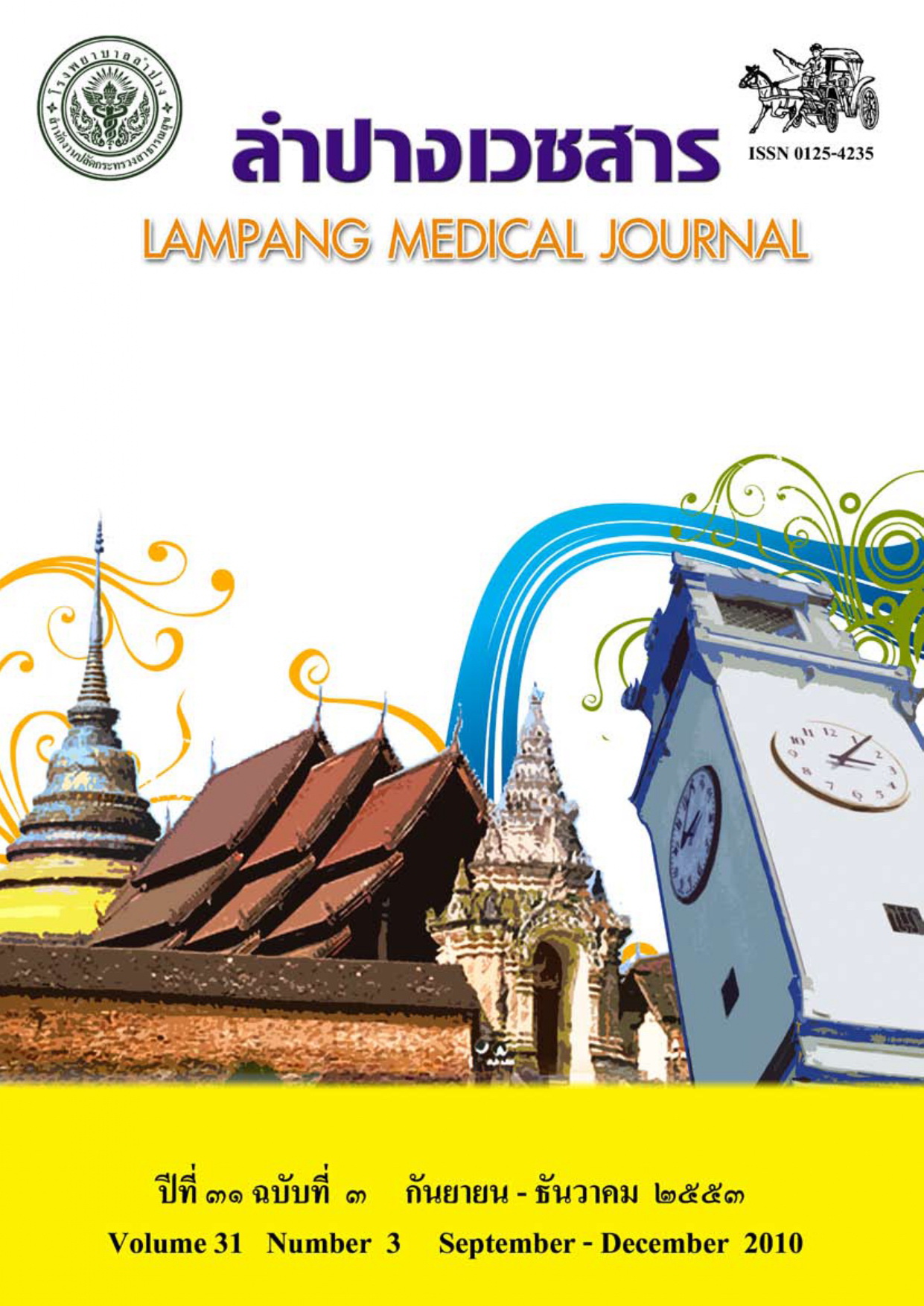Recyclable Waste Bank Management in Lampang Hospital
Main Article Content
Abstract
Background : Growing amount of waste materials has become one of the major problems in Lampang Hospital. To solve this problem, the recyclable waste bank management has been implemented since August 2009.
Objective : To study the management of recyclable waste bank in Lampang Hospital and its affecting factors.
Material and method : A descriptive study was conducted during August 2009 to September 2010. Data of the Lampang Hospital Recyclable Waste Bank were collected from the record form, monthly report and co-operation report, including member’s satisfaction and objection. Data was analyzed by descriptive statistics.
Results : According to the hospital director policy, the recycle waste were segregated from the officer’s workplaces or household and brought to the bank for receiving an earning. In fiscal year 2010, the 292,167 kilograms solid waste was produced in Lampang Hospital as 42.3% recycled waste and 40.7% infectious waste. The Recyclable Waste Bank got 536 members from the personals
and business units with 123,716 kilograms of recycled waste and made the deposit balance of 376,571 baht. The top three of recycle wastes were paper (57.0%), glass (19.3%) and plastics (19.2%). Comparing with fiscal year 2009, percentage of recyclable waste increment was average 14.9% every month for recyclable waste and 13.8% reduction for infectious waste. Most of the
members satisfied the opening hours in the weekend and no any complaint from the surrounding communities was found.
Conclusion : The Lampang Hospital Recyclable Waste Bank management was highly effective, classified as KPI level 5 every month. Percentage of recyclable waste increment was over 5%. The affecting factors were the members’ participation to segregate waste from the workplace, awareness of environmental protection, saving natural resources and getting monetary value to
the waste they deposit.
Article Details

This work is licensed under a Creative Commons Attribution-NonCommercial-NoDerivatives 4.0 International License.
บทความที่ส่งมาลงพิมพ์ต้องไม่เคยพิมพ์หรือกำลังได้รับการพิจารณาตีพิมพ์ในวารสารอื่น เนื้อหาในบทความต้องเป็นผลงานของผู้นิพนธ์เอง ไม่ได้ลอกเลียนหรือตัดทอนจากบทความอื่น โดยไม่ได้รับอนุญาตหรือไม่ได้อ้างอิงอย่างเหมาะสม การแก้ไขหรือให้ข้อมูลเพิ่มเติมแก่กองบรรณาธิการ จะต้องเสร็จสิ้นเป็นที่เรียบร้อยก่อนจะได้รับพิจารณาตีพิมพ์ และบทความที่ตีพิมพ์แล้วเป็นสมบัติ ของลำปางเวชสาร
References
กรมควบคุมมลพิษ. ข้อมูลการลดและใช้ประโยชน์ขยะมูลฝอยชุมชนของเทศบาล. [สืบค้น 21 พฤษภาคม 2553] แหล่งที่มา: URL:http://www.pcd.go.th/info_serv/waste_municip.html
กองสุขาภิบาล กรมอนามัย กระทรวงสาธารณสุข. เอกสารประกอบการอบรมเรื่อง การดำเนินงานสุขาภิบาลสิ่งแวดล้อมของโรงพยาบาลชุมชนขนาด 10, 30 เตียง. นนทบุรี: กระทรวงสาธารณสุข; 2539.
พัชรา ฉัตรานุภาพ. ศึกษาการคัดแยกขยะมูลฝอยและมูลฝอยติดเชื้อ ณ แหล่งกำเนิดในโรงพยาบาลลำปาง [วิทยานิพนธ์ศิลปศาสตรมหาบัณฑิต]. สาขาวิชาการจัดการมนุษย์กับสิ่งแวดล้อม, บัณฑิตวิทยาลัย, เชียงใหม่:มหาวิทยาลัยเชียงใหม่; 2541.
โรงพยาบาลลำปาง. รายงานประจำปี 2552. ลำปาง: โรงพยาบาลลำปาง; 2552.
รวิกานต์ แสนไชย. การมีส่วนร่วมของชุมชนในการจัดการแบบยั่งยืน:กรณีศึกษาธนาคารขยะชุมชนวัดกลาง
เขตบางกะปิ กรุงเทพมหานคร [วิทยานิพนธ์ศิลปศาสตรมหาบัณฑิต]. สาขารัฐศาสตร์, บัณฑิตวิทยาลัย, กรุงเทพมหานคร: มหาวิทยาลัยรามคำแหง; 2544.
บัณฑิต เอื้อวัฒนานุกูล, ไพฤทธิ์ สุขเกิด. ความสำเร็จของชุมชนในการมีส่วนร่วมจัดการขยะมูลฝอย กรณีศึกษาโครงการศูนย์วัสดุรีไซเคิลและธนาคารขยะของคณะกรรมการจัดการสิ่งแวดล้อมชุมชน เขตบางกะปิ กรุงเทพฯ. นนทบุรี: ธรรมกมลการพิมพ์; 2544.
กรุณา กลัดเนินกลุ่ม. การดำเนินการของธนาคารขยะชุมชนร่วมกันสร้าง ปัญหาพิเศษ รป.ม. ชลบุรี: มหาวิทยาลัยบูรพา; 2546.
เสถียร รุจิวนิช. รายงานการวิจัยการประเมินผลได้ทางเศรษฐกิจจากการคัดแยกขยะชุมชน. กรุงเทพมหานคร: จุฬาลงกรณ์มหาวิทยาลัย; 2544.
ศรัณย์พร หงศาลา. การดำเนินโครงการธนาคารขยะรีไซเคิล เทศบาลตำบลพนมไพร อำเภอพนมไพร จังหวัดร้อยเอ็ด [วิทยานิพนธ์วิทยาศาสตรมหาบัณฑิต] สาขาวิชาการบริหารจัดการสิ่งแวดล้อม, บัณฑิตวิทยาลัย, มหาสารคาม: มหาวิทยาลัยมหาสารคาม; 2551.


